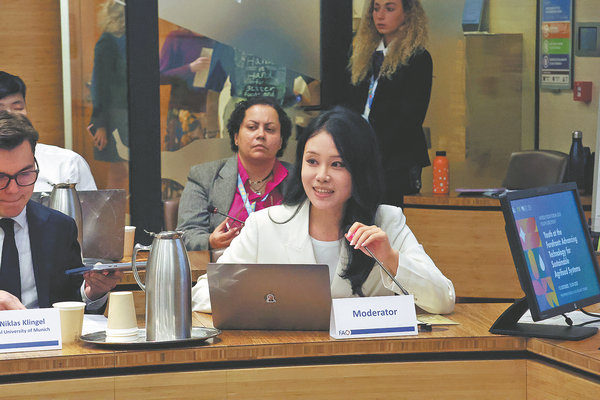

When I stepped into the headquarters of the Food and Agriculture Organization of the United Nations (FAO) in Rome, Italy, for the Fifth World Food Forum (WFF), held from Oct 10 to 17, one line engraved on the marble wall immediately caught my attention — the FAO Constitution's pledge "to contribute toward an expanding world economy and ensuring humanity's freedom from hunger".
Those words, carved decades ago, felt newly alive as young innovators around me spoke passionately about artificial intelligence, robotics, and data-driven farming. The spirit that once called for collective action to end hunger has found a new generation — one fluent in digital languages and determined to turn technology into a force for inclusion and sustainability.
During the forum, I had the honor of moderating a side event, "Youth at the Forefront: Advancing Technology for Sustainable Agrifood Systems", hosted by Tsinghua University in collaboration with Sinomach Digital Technology Corporation, the United Nations Industrial Development Organization (UNIDO), and Politecnico di Milano.
The session brought together over 100 participants to explore how technology and youth can work hand in hand to make agriculture smarter, greener, and fairer.
One story that stood out came from Noe Gabriel Alexandre Michon, a young innovator from France who developed an AI-based pest detection app. By simply uploading a photo of a leaf, farmers can instantly identify crop diseases and act before losses occur.
Meanwhile, Chinese entrepreneur Leng Wei from Wuhan Jiahe Technology introduced drone and sensor systems that monitor irrigation in real time, helping farmers save water while increasing yields.
These were not abstract ideas but real-world solutions already taking root — proof that innovation can be both high-tech and human-centered.
Seated alongside experts from FAO, UNIDO, and the World Food Program (WFP), I sensed a quiet revolution. For once, the discussion was not about what young people might contribute someday — it was about what they are already doing today.
It felt like a generational dialogue between experience and experimentation, where knowledge meets creativity and progress grows through genuine collaboration.
Yet, technology alone cannot feed the world. Many rural areas remain disconnected from digital infrastructure. Without affordable access, digital literacy, and supportive public policy, even the most advanced tools risk deepening inequalities.
As Niklas Klingel from the Technical University of Munich aptly noted, "A smartphone app cannot irrigate a field without water governance behind it". True innovation must be inclusive — bridging not only technological gaps but also social and institutional ones.
Digital changemakers
During a coffee break, I spoke with delegates from Africa, Asia, and Latin America who shared their own local experiments — from digital cooperatives linking farmers to markets to AI models predicting droughts before they devastate harvests. Despite their different realities, one message resonated: young people are no longer waiting to be empowered — they are already empowering others.
As our session concluded, the applause carried more than gratitude — it carried a sense of possibility. Though it was just one side event among many, it reflected something fundamental: the FAO's founding vision is being renewed by the hands of the digital generation. Technology has become a new language of solidarity and innovation, a bridge between aspiration and action.
At that moment, I was reminded of Tsinghua's motto — "Self-discipline and Social Commitment". It captures the very essence of what today's youth must embody: the perseverance to innovate and the moral strength to uplift others.
The words on the FAO's wall — "ensuring humanity's freedom from hunger" — no longer felt like a distant aspiration, but a mission I could help realize.
Written by Li Mingyue, a master's student at Tsinghua University's School of Journalism and Communication and a volunteer at the United Nations Resident Coordinator's Office in China.